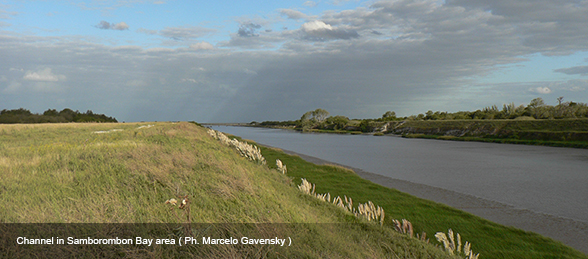Samborombon Bay
GO TOP
Pampas grassland and estuary in Samborombon Bay
About 200 kilometres south-east from Buenos Aires city there is a place where the endangered Pampas grassland ecosystem can still be found fairly well preserved. It is the area of Samborombon bay, which also preserves a huge wetland, very important for lots of aquatic and migratory birds, such as ducks, swans and waders.

Some of the Pampa's most representative species still inhabit the area, such as the Greater Rhea and Spotted Nothura. They live in grassland areas, and share their habitat with other species like the Burrowing Owl, Campo Flicker, Firewood-gatherer, Freckle-breasted Thornbird, Short-billed Pipit, Hellmayr's Pipit, Grassland Yellowfinch, Grassland Sparrow, Great Pampa-finch, Brown-and-yellow Marshbird and the White-browed Blackbird. Some raptors like the White-tailed Kite, Long-winged Harrier, Cinereus Harrier and the White-tailed Hawk are very likely to be seen in a tour to this area. In the summer there are chances to find the migratory Swainson's Hawk, which was under threat a few decades ago because of the use of pesticides. Other migrants that use these grasslands for feeding are the Upland Sandpiper and Buff-breasted Sandpiper in the summer, and the Tawny-throated Dotterel and Austral Negrito in the winter, among many others.

In the summer this is a very good place to finding some species of swallows which are very scarce in Buenos Aires city and surroundings, such as the Bank Swallow, Cliff Swallow and Barn Swallow, and other commoner species like the Brown-chested Martin and White-rumped Swallow. In the winter the Chilean Swallow comes from Patagonia to spend its non breeding season in the area.

But the specialties of these beautiful fields are the scarce Hudson's Canastero and Bay-capped Wren-spinetail. They live in the best preserved grasslands, being the first one more likely to be found in areas with presence of Cord-grass (Spartina spp.), and the second one in reeds and flooded grasslands. More rare and hard to spot is the Dot-winged Crake. They are among the endemic species of the Pampas grassland ecosystem.

This part of the Pampas also preserves wetlands, rivers and channels that are part of La Plata river estuary. This estuary is an important stop for lots of migratory birds that breed in the steppes of the Arctic and travel all the way down to southern South America to spend their non breeding season in this productive habitat. Some of them to be quoted are the American Golden-plover, Semipalmated Plover, Greater Yellowlegs, Lesser Yellowlegs, Pectoral Sandpiper, White-rumped Sandpiper and the remarkable Hudsonian Godwit. Among the winter visitors that arrive from the south there is the Two-banded Plover and the Rufous-chested Dotterel. There are also many non-migrating aquatic species, although some of them make short distance moves looking for appropriate habitat and breeding grounds. The most remarkable ones could be the beautiful Roseate Spoonbill, some storks like the Wood Stork and Maguari Stork, the magnificent Chilean Flamingo, Southern Screamer, Coscoroba Swan, Black-necked Swan, Southern Wigeon, Cinnamon Teal, Silver Teal and the scarce Black-headed Duck. Other scarce although expectable aquatic birds in the area are Olrog's Gull, Gull-billed Tern, Yellow-billed Tern and the stunning Black Skimmer, moving in flocks while skimming the water surface with their peculiar bills.

All this, in addition to other remarkable fauna that can be found in a day trip, such as armadillos (Dasypus and Chaetophractus sp.) and the tucu-tucos (Ctenomys sp.), make of this place a wonderful gateway to the Pampas grassland ecosystem and La Plata river estuary.